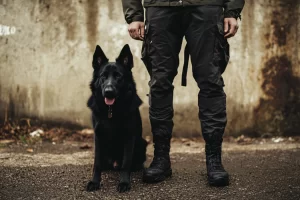Tired Of Your German Shepherd Jumping Onto People?
Teaching a German Shepherd not to jump on people is a valuable skill that benefits both the dog and its human companions. German Shepherds are known for their intelligence, loyalty, and boundless energy, which, without proper training, can manifest in less desirable behaviors such as jumping up. Effective training to curb this behavior not only enhances the quality of interactions between pets and people but also ensures safety and reinforces respect for personal boundaries. This training process is crucial, especially given the size and strength of German Shepherds, which can make their jumping intimidating or harmful without intention.
Understanding Your German Shepherd’s Psychology
Jumping up is an innate behavior in dogs. Puppies often jump up to greet their mother and to get her attention, signaling their need for interaction. When puppies display this behavior, it is usually perceived as cute or harmless. However, as a dog matures, especially a large breed like the German Shepherd, what was once cute can become a problem or even a safety hazard. Jumping up in adult dogs is often an expression of excitement or an attempt to get attention. Recognizing that this behavior is not aggressive but rather a form of communication is crucial in effectively addressing and modifying it.
Teaching Your German Shepherd What Is and Is Not Allowed
The cornerstone of effective dog training is a strong relationship founded on trust and mutual respect. Training should consistently be a positive, rewarding experience for the dog. This positive reinforcement approach is particularly vital when teaching a German Shepherd not to jump up. The training regimen should start with basic obedience commands such as “sit,” “stay,” and “down.” These commands are not only essential for immediate control but also serve as a foundation for teaching the dog how to behave appropriately in various situations.
Preventing Your German Shepherd from Practicing Bad Behavior
Preventing unwanted jumping is a critical component of training. A powerful method to discourage this behavior is to ignore the dog when it jumps up. By turning away and avoiding eye contact, the owner can teach the dog that jumping up will not garner any attention. Once the dog calms down and all four paws are on the ground, it should then be given attention and possibly treats. This method requires consistent application from all members of the household and any visitors to ensure the dog receives a uniform message about acceptable behavior.
Training Your German Shepherd Positive Reinforcement
Positive reinforcement is a strategy that rewards the behavior one wishes to encourage. For curbing jumping, this involves praising or rewarding the German Shepherd whenever it remains calm and keeps all four paws on the ground upon greeting. Immediate rewards are crucial as they help the dog make the connection between the desired behavior and the positive outcome. This reinforcement can include treats, petting, or verbal praise, and should be administered right after the appropriate behavior is displayed.
Training Techniques for Your German Shepherd
Teaching a German Shepherd an alternative behavior that is incompatible with jumping up is another effective strategy. For instance, training the dog to “sit” to greet people ensures that it cannot jump at the same time. Regular practice of this technique reinforces that sitting politely is a more appropriate greeting than jumping. Over time, the dog will learn to default to sitting rather than jumping up when meeting someone new.
Incorporating additional techniques to train a German Shepherd puppy not to jump on people can further enhance the training regimen, making it more comprehensive and adaptable to different situations. One such technique involves the use of body blocks or spatial pressure to communicate to the puppy that jumping is not acceptable. This method requires the trainer to step forward into the space where the puppy intends to jump, thereby using their presence to block the action. It’s a way of using body language to set boundaries, showing the puppy that they must respect personal space. This method should be used cautiously and consistently, ensuring the puppy does not perceive it as a threat but rather as a leadership gesture. It’s crucial to immediately reward the puppy when it responds by backing down or sitting, reinforcing that respecting space earns positive outcomes.
Another effective strategy is setting up controlled training scenarios that simulate the situations where the puppy might be tempted to jump. This could involve having a family member or a friend approach the puppy, allowing the trainer to practice redirecting the puppy’s behavior in a safe and controlled environment. The visitor can be instructed to only give attention when the puppy is calm and has all four paws on the ground. Over time, these practice sessions help the puppy learn that keeping four paws on the ground is the only way to receive the desired attention and affection. This technique not only helps in reducing jumping behavior but also aids in socializing the puppy with various people, reinforcing good manners irrespective of the excitement level or the novelty of the situation.
Managing and Redirecting Your German Shepherd Energy
German Shepherds are a high-energy breed requiring ample physical exercise and mental stimulation. A common reason these dogs jump up is simply due to excess energy and excitement. Providing adequate physical activities such as long walks, runs, or play sessions helps mitigate this energy overflow. Similarly, mental stimulation through puzzle toys, training exercises, and interactive games like hide-and-seek can keep the dog mentally engaged and less likely to exhibit hyperactive behavior.
Professional Help When You Can’t Get It Done Yourself
If the jumping persists or the dog’s owner feels overwhelmed, seeking help from a professional dog trainer can be invaluable. Experienced trainers bring a depth of understanding of canine behavior and can offer personalized advice and strategies specifically tailored to an individual dog’s needs. This professional intervention can be particularly helpful in cases where the dog’s behavior is stubborn or the owner is new to dog handling.
Consistency and Patience While Training Your GSD
Successfully training a German Shepherd not to jump up demands consistency and patience. Each interaction with the dog is an opportunity for reinforcing training. Maintaining uniformity in commands, rewards, and corrective measures helps the dog learn and adhere to expected behaviors. Patience plays a critical role as behavior modification does not happen overnight. Commitment to the ongoing training process is essential for achieving lasting results.
Conclusion
At Czech Working Line, we believe raining a German Shepherd not to jump on people significantly enhances the dog’s social skills and its interactions with humans. This training requires an understanding of the underlying behavior, application of effective training techniques, and a consistent approach. The resulting bond that develops through this structured engagement is deeply rewarding and leads to a well-mannered dog that is a joy to be around.




